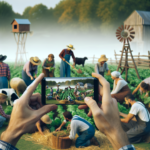Welcome to our Comprehensive Guide on Farm Products
Isn’t agriculture amazing? The very food we eat, the clothes we wear, and even some of the energy we use, have their origins in farming. I’ve always found fascination in the bountiful array of farm products.
In this article, we will explore farm products in a detailed and interactive manner. We’ll define what farm products are and look closely at the different types of crops and livestock that form these products.
Ever wondered about the various channels that these farm products take before becoming readily available for your consumption? We’ll explore this, touching on everything from local markets to wholesale retailers and even exports. We’ll also glimpse at the packaging of these products and the significant role it plays in quality maintenance, transportation, storage, and marketing.
Remember, just like George Washington Carver, the famous agricultural scientist said, “Agriculture not only gives riches to a nation but the only riches she can call her own.”
Ready? Let’s explore!
Understanding Farm Products
Definition of Farm Products
Farm products encompass a wide range of goods produced from agriculture. They can be broadly classified into two categories:
- Crops
- Livestock
Types of Crops
Crops are plants cultivated for various purposes. Below are the primary categories:
- Grains: Includes wheat, rice, corn, and barley.
- Fruits: Such as apples, oranges, and strawberries.
- Vegetables: Covers items like potatoes, carrots, and spinach.
- Legumes: Includes beans, lentils, and peanuts.
- Oilseeds: Such as soybean and sunflower seeds.
Types of Livestock
Livestock products derive from animals raised on farms. They are divided into:
- Meat: Beef, pork, lamb, and poultry.
- Dairy: Milk, cheese, and yogurt.
- Eggs: Mainly chicken eggs.
- Wool: The fiber from sheep.
- Honey: Produced by bees.
Importance of Farm Products
Farm products are vital for various reasons:
- Food Supply: They provide essential nutrients and calories for the global population.
- Economic Value: Agriculture significantly contributes to the GDP of many countries.
- Industrial Usage: Some farm products serve as raw materials for industries, e.g., corn for ethanol.
- Employment: Farming provides jobs for millions worldwide.
Market and Distribution
Farm products can enter the market through different channels:
| Channel | Description |
|---|---|
| Local Markets | Direct sales to consumers in local areas. |
| Wholesale Markets | Products sold in bulk to retailers and food processors. |
| Export | Sending farm products to international markets. |
For further reading on farm products and their impact, you can visit this USDA web page.
Packaging of Farm Products
Significance of Packaging
The packaging of farm products plays a pivotal role in their quality maintenance, transport, storage, and marketing. It is a critical component in managing loss of produce during transit, preserving the freshness of goods, and ensuring the retainment of nutrients. Moreover, effective packaging contributes significantly to the attractive presentation of a product, thereby impacting consumer choices.
Types of Farm Product Packaging
Farm goods are typically packaged using various materials, depending on the type and requirements of the products:
- Plastic: Bags, containers, films, and trays made of plastic are commonly used for packaging fruits, vegetables, and dairy goods.
- Cardboard: Often employed for packing eggs, grains, and larger quantities of fruits or vegetables.
- Steel: Used for canning fruits, vegetables, and meat for extended shelf life.
- Glass: Ideal for packing items like honey, pickles, and jams.
- Wood: Crates made of wood are often used for packing bigger fruits like melons.
Packaging Techniques
The methods of packaging vary with the nature of the farm product:
- Vacuum Packaging: This method, primarily used for meat and dairy products, involves sealing the product in an airtight environment to extend its shelf life.
- Modified Atmosphere Packaging: This technique is used for fruits and vegetables to slow down their respiration rate and maintain freshness.
- Shrink Wrapping: This involves wrapping a plastic film around the product and applying heat to seal it. This is generally used for bundling products together for transport.
- Bag-in-Box: This technique, often used for liquids such as fruit juice or milk, involves placing a flexible plastic bag within a corrugated fiberboard box.
Factors Impacting Packaging Choices
Several aspects influence the selection of packaging for farm products:
- Product Characteristics: The nature, size, and perishability of the product directly affect the kind of packaging required.
- Cost: The affordability of the packaging material is a crucial factor, especially for small scale farmers and producers.
- Environmental Impact: Using recyclable or biodegradable materials is increasingly being prioritized to reduce environmental harm.
- Regulatory Compliance: Packaging must adhere to the food safety and health regulations of the country.
For more information on the packaging of farm products, check out this article on the FAO website.
Best Packaging for Agricultural Products
Criteria for Optimal Packaging
Choosing the best packaging for agricultural products involves considering factors that will protect and preserve the goods from the farm to the consumer. Optimal packaging should be:
- Cost-Effective: Affordable for farmers, especially for those operating on a smaller scale.
- Durable: Strong enough to withstand the rigors of transportation without damaging the contents.
- Recyclable or Biodegradable: Environmentally friendly to reduce waste and pollution.
- Compliance with Regulations: Adheres to all safety and health regulations to ensure consumer safety.
Packaging Materials and Their Uses
Different materials are used for packaging depending on the type and nature of the farm product:
| Material | Use |
|---|---|
| Plastic | Ideal for fruits, vegetables, and dairy products. Examples include plastic bags, containers, and films. |
| Cardboard | Common for packing eggs, grains, and large quantities of fruits and vegetables. |
| Steel | Used for canning fruits, vegetables, and meats to extend shelf life. |
| Glass | Best for items like honey, pickles, and jams due to its preservative qualities. |
| Wood | Employed for packing larger fruits like melons, providing robust protection. |
Advanced Packaging Solutions
In recent years, advanced techniques have been developed to enhance the efficacy of agricultural product packaging:
- Active Packaging: Incorporates components that actively interact with the product to extend shelf life, such as moisture absorbers or antimicrobial agents.
- Intelligent Packaging: Utilizes technology like QR codes and RFID tags to monitor the condition of the packaging and its contents, providing real-time data on freshness and safety.
- Edible Coatings: These are thin layers applied directly to the product, particularly fruits and vegetables, to enhance longevity and reduce the need for conventional packaging.
Biodegradable and Sustainable Options
As the world shifts towards more sustainable practices, biodegradable packaging materials are gaining prominence:
- Bioplastics: Derived from renewable biomass sources such as corn starch or sugarcane, they decompose more easily than traditional plastics.
- Natural Fibers: Materials made from bamboo, jute, or other plant sources are used for making bags, crates, and other packaging solutions.
Packaging Innovations in Response to Consumer Trends
Modern consumer preferences influence packaging decisions profoundly:
- Convenience: Ready-to-eat and easy-to-open packaging options are popular. For example, pre-cut vegetables in resealable bags.
- Transparency: Consumers prefer packaging that allows them to see the product inside, ensuring freshness and quality.
Incorporating these advancements and trends can help in selecting the best packaging for your specific agricultural products, enhancing their marketability and ensuring they reach consumers in optimal condition. For more insights, check out the related resources on the FAO website.
Conclusion
Farm products are an indispensable part of our lives, providing not only our primary source of sustenance but also contributing significantly to global economies and job markets. Categorized primarily into crops and livestock, they offer diverse produce ranging from grains, fruits, vegetables to meats and dairy. Their distribution through local markets, wholesale, and export platforms allow these products to reach consumers globally.
Moreover, the packaging of farm products occupies a vital role, ensuring quality maintenance, efficient transport, and effective marketing. Packaging choices often depend on the product, cost, and regulatory compliances. The selection of packaging materials and deployment of advanced packaging techniques significantly influence the lifespan, appeal, and environmental impact of these products.
Frequently Asked Questions – FAQs
What are the main categories of farm products?
Farm products are mainly categorized into crops and livestock, including grains, fruits, vegetables, meats, dairy goods, and more.
Which factors influence the packaging of farm products?
Packaging of farm products depends on the type of the product, cost, environmental impact, and adherence to food safety and health regulations.
How are farm products distributed in the market?
Farm products make their way into the market through local sales, wholesale vendors, and exports to international markets.
Why is packaging an important aspect of farm products?
Packaging helps maintain the quality of farm products, assists in transport and storage, and plays a significant role in marketing the products effectively.






